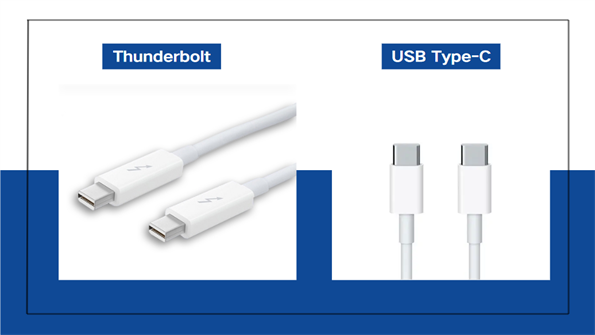Is Thunderbolt And USB-C The Same?
Time:2025-06-09 14:10:29
Visit:342

In today's technology-driven world, understanding the various ports and connectors can be a bit overwhelming. Two terms that often come up in conversations about modern devices are Thunderbolt and USB-C. They may look similar, but are they the same? Let's explore the differences and similarities between Thunderbolt and USB-C to help you make informed decisions about your tech purchases.
To get started, let's clarify what Thunderbolt and USB-C actually are. Both are types of connectors used to connect devices, but they serve different purposes and have distinct capabilities.
What is USB-C?
USB-C, or USB Type-C, is a universal connector standard that was developed to simplify the connection of peripherals to computers. It is designed to replace older USB standards (like USB-A and USB-B) and offers several advantages over its predecessors:
- • Reversible Design: Unlike older USB connectors, USB-C can be plugged in either way, making it more user-friendly.
- • Fast Data Transfer: USB-C supports high-speed data transfer rates, typically up to 10 Gbps with USB 3.1.
- • Power Delivery: It can deliver up to 100 watts of power, allowing for faster charging of devices like laptops and smartphones.
What is Thunderbolt?
Thunderbolt is a hardware interface developed by Intel in collaboration with Apple. It is often found in high-performance computers and peripherals.
- • High-Speed Data Transfer: Thunderbolt can transfer data at speeds up to 40 Gbps, which is four times faster than USB-C.
- • Multiple Protocols: Thunderbolt supports multiple protocols, including PCI Express and DisplayPort, allowing for versatile uses like connecting external graphics cards and high-resolution displays.
- • Daisy Chaining: You can connect multiple Thunderbolt devices in a daisy chain, reducing cable clutter and improving organization.
Thunderbolt vs USB-C: The Key Differences
| Feature | Thunderbolt 3 | Thunderbolt 4 | USB 3.2 | USB4 |
| Data Transfer Speed | Up to 40 Gbps | Up to 40 Gbps | Up to 20 Gbps | Up to 40 Gbps |
| Display | One 4K monitors | Two 4K monitors or one 8K monitor | One 4K monitors | Two 4K monitors or one 8K monitor |
| Power Delivery | Up to 100W | Up to 100W | Up to 100W | Up to 100W |
| Daisy- Chaining | Up to 6 devices | Up to 4 devices | Not supported | Not supported |
| Passive cable length | 0.5m | 0.5m- 0.8m | 1m | 0.5m-1m |
| Connector | USB C | USB C |
USB C |
USB A, USB B and USB C |
While USB-C and Thunderbolt share some similarities, they have key differences that set them apart.
Speed and Performance
One of the most significant differences between Thunderbolt and USB-C is their speed and performance. Thunderbolt offers much faster data transfer rates, up to 40 Gbps, compared to USB-C's maximum of 10 Gbps. This makes Thunderbolt ideal for tasks that require high-speed data transfer, such as video editing and large file transfers.
Compatibility
USB-C is more widely compatible than Thunderbolt. Most modern devices, including smartphones, tablets, and laptops, come with USB-C ports. In contrast, Thunderbolt is primarily found in high-end computers and peripherals. However, it's essential to note that Thunderbolt ports are compatible with USB-C devices, but not all USB-C ports support Thunderbolt.
Cost
Due to its advanced capabilities, Thunderbolt technology tends to be more expensive than USB-C. If you're on a budget and don't require the high-speed performance of Thunderbolt, USB-C is a more cost-effective choice.
Power Delivery
Both USB-C and Thunderbolt support power delivery, but Thunderbolt can handle more power, which is beneficial when connecting power-hungry devices like external graphics cards. However, for most everyday uses, USB-C's power delivery capabilities are more than sufficient.
Thunderbolt vs USB-C: Use Cases
When to Choose Thunderbolt
Thunderbolt is the go-to choice for professionals who need high-speed data transfer and versatility. Here are some scenarios where Thunderbolt shines:
- • Video Editing: If you work with high-resolution video files, Thunderbolt's fast data transfer rates make it an excellent choice for seamless editing and rendering.
- • External Graphics Cards: Thunderbolt's support for PCI Express allows you to connect external GPUs, enhancing your computer's graphical capabilities.
- • High-Resolution Displays: Thunderbolt can drive multiple 4K displays or a single 5K display, making it ideal for creative professionals and gamers.
When to Choose USB-C
USB-C is suitable for everyday use and general connectivity needs. Here are some scenarios where USB-C is the better option:
- • Charging Devices: USB-C's power delivery capabilities make it perfect for charging smartphones, tablets, and laptops quickly and efficiently.
- • Data Transfer: For transferring files between devices, USB-C's 10 Gbps speed is more than adequate for most users.
- • General Connectivity: USB-C is widely adopted, making it the perfect choice for connecting peripherals like keyboards, mice, and external storage devices.
The Future of Thunderbolt and USB-C
As technology continues to evolve, both Thunderbolt and USB-C are expected to see further advancements. USB4, for example, is the next iteration of USB technology and will incorporate Thunderbolt 3's capabilities, offering speeds up to 40 Gbps. This convergence may blur the lines between the two technologies even further.
Conclusion
In conclusion, while Thunderbolt and USB-C may look similar, they serve different purposes and have unique capabilities. Thunderbolt is the choice for high-speed, professional applications, while USB-C is versatile and widely compatible, making it ideal for everyday use. Understanding their differences will help you make informed decisions when selecting devices and accessories.
Whether you're connecting a high-resolution display, charging your smartphone, or transferring files, both Thunderbolt and USB-C have their place in the modern tech ecosystem. Consider your specific needs and budget to choose the right connector for your devices.
